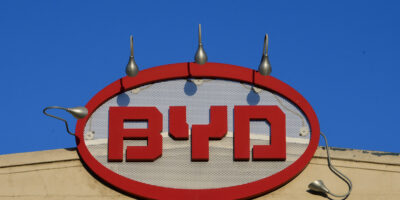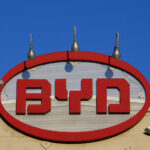
NVIDIA DRIVE map night scene (Source – NVIDIA)
BYD and Lucid adopt NVIDIA DRIVE for next generation fleets
As autonomous cars are expected to take over the roads soon, two autonomous car manufacturers are looking to leverage NVIDIA’s DRIVE Orin together with the NVIDIA DRIVE platform and the next generation of NVIDIA DRIVE Hyperion architecture.
“DRIVE is our autonomous vehicle system. It is essentially our AI chauffeur. As with all of our platforms, NVIDIA DRIVE is full-stack, end to end, and open for developers to use in whole or in parts,” said Jensen Huang, founder and CEO of NVIDIA during his keynote at GTC.
At the GTC event, NVIDIA also announced that its automotive pipeline has increased following a series of design wins with vehicle makers from around the globe. Currently, more than 25 vehicle makers have adopted the NVIDIA DRIVE Orin system-on-a-chip (SoC).
Starting this year, they are introducing software-defined vehicles, built on the centralized AI compute platform. DRIVE Hyperion with NVIDIA Orin serves as the central nervous system and AI brain for new energy vehicles. It delivers constantly improving cutting-edge AI features while ensuring safe and secure driving capabilities.
Two carmakers, BYD and Lucid Group have also announced that they are adopting NVIDIA DRIVE for their next-generation fleets. China’s BYD, one of the world’s best-selling EV brands, will roll out next-generation NEVs built on the DRIVE Hyperion software-defined platform starting in early 2023. These fleets will tap the power of DRIVE Orin to enable intelligent driving, parking capabilities, and more.
Meanwhile, Lucid revealed that its DreamDrive Pro advanced driver-assistance system is built on NVIDIA DRIVE. The NVIDIA centralized compute architecture is seamlessly integrated with the ADAS hardware of every Lucid Air sedan delivered today. DreamDrive Pro is designed to grow in capability with over-the-air software updates through future-ready hardware already in place in the vehicle — enhancing the driving experience for customers with new functions and advanced features over time.
“Future cars will be fully programmable, evolving from many embedded controllers to powerful centralized computers — with AI and AV functionalities delivered through software updates and enhanced over the life of the car. NVIDIA DRIVE Orin has been enormously successful with companies building this future, and is serving as the ideal AV and AI engine for the new generation of EVs, robotaxis, shuttles, and trucks,” added Huang.
20 of top 30 EV manufacturers use NVIDIA DRIVE

NVIDIA DRIVE Orin. (Source – NVIIDAI)
In addition to BYD and Lucid, new energy vehicle (NEV)startups such as NIO, Li Auto, XPeng, SAIC’s IM Motors and R Auto Brands, JiDU, Human Horizons, VinFast, WM Motor, and others are also all developing software-defined fleets on DRIVE.
With these latest announcements, NVIDIA DRIVE Orin has become the choice AI compute platform for 20 of the top 30 passenger electric vehicle makers in the world.
NVIDIA also announced that since April 2021, it’s total automotive design win pipeline has increased from US$ 8 billion to more than US$ 11 billion over the next six years, spanning the entire autonomous vehicle industry. This includes the top EV makers to world-renowned automakers Jaguar Land Rover, Mercedes-Benz, and Volvo Cars, to leading trucking companies including Plus, TuSimple and Volvo Autonomous Solutions, and cutting-edge robotaxi manufacturers AutoX, DiDi, Pony.ai, and Zoox.
Huang also announced the next generation of the DRIVE Hyperion architecture, built on the Atlan computer, for vehicles starting to ship in 2026. The DRIVE Hyperion platform is designed to be compatible across generations, with the same computer form factor and NVIDIA DriveWorks APIs. Partners can leverage current investments in the DRIVE Orin platform and seamlessly migrate to NVIDIA DRIVE Atlan and beyond.
The platform includes the computer architecture, sensor set, and full NVIDIA DRIVE Chauffeur and Concierge applications. It is designed to be open and modular, so customers can select what they need. Current-generation systems scale from NCAP to level 3 driving and level 4 parking with advanced AI cockpit capabilities.
The next-generation platform will increase performance for processing sensor data, further enhancing safety and extending the operating domains of full self-driving. DRIVE Hyperion 9 will feature 14 cameras, nine radars, three lidars, and 20 ultrasonics as part of its sensor suite.
READ MORE
- Ethical AI: The renewed importance of safeguarding data and customer privacy in Generative AI applications
- How Japan balances AI-driven opportunities with cybersecurity needs
- Deploying SASE: Benchmarking your approach
- Insurance everywhere all at once: the digital transformation of the APAC insurance industry
- Google parent Alphabet eyes HubSpot: A potential acquisition shaping the future of CRM


